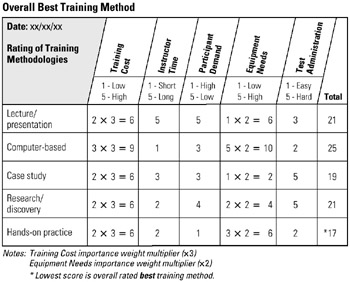Tool 160: Rating Matrix
| AKA | Criteria Rating |
| Classification | Evaluating/Selecting (ES) |
Tool description
The rating matrix tool is used to rate a list of options against a team-established set of necessary criteria or guidelines in order to identify the perceived "best" option. Greater weight can be assigned to a more important criterion using a multiplier factor. The lowest total score on the rating matrix suggests the best option.
Typical application
-
To evaluate and rate a number of options available to the team.
-
To determine a preferred or perceived best problem solution or process-improvement opportunity.
-
To assist a team in reaching consensus.
-
To decide on what action the team should take as the next step.
Problem-solving phase
| → | Select and define problem or opportunity |
| Identify and analyze causes or potential change | |
| → | Develop and plan possible solutions or change |
| → | Implement and evaluate solution or change |
| → | Measure and report solution or change results |
| → | Recognize and reward team efforts |
Typically used by
| 5 | Research/statistics |
| Creativity/innovation | |
| Engineering | |
| 4 | Project management |
| Manufacturing | |
| 3 | Marketing/sales |
| Administration/documentation | |
| Servicing/support | |
| 2 | Customer/quality metrics |
| 1 | Change management |
before
-
6-3-5 Method
-
Brainwriting Pool
-
Brainstorming
-
Data Collection Strategy
-
Focus Group
after
-
Action Plan
-
Run-It-By
-
Potential Problem Analysis (PPA)
-
Project Planning Log
-
Different Point of View
Notes and key points
-
Assign ratings of 1–5 in accordance with how well each training method meets the criteria. A rating of 1 (low) is the preferred method; the lowest total score is the overall best training method.
-
If a particular criterion is perceived to be of higher importance, a multiplier factor can be applied as shown in the example. The raiting is multiplied by the multiplier factor to give the criterion greater weight, or in other words, a higher rating score.
Step-by-step procedure
-
STEP 1 The team determines the criteria and scales to be used for rating all options. See example Overall Best Training Method.
-
STEP 2 A rating matrix is constructed with the rating criteria and scales shown on top. Ensure that all numerical scales and translations do not conflict with "lower rating is better" approach.
-
STEP 3 The team rates how well each option meets the established criteria. If a particular criterion is suggested to be more important, a multiplier value can be assigned for greater weight as seen in the example.
-
STEP 4 After all options have been rated, the scores are added across the matrix to arrive at total scores. The lowest total score is rated as the best option.
-
STEP 5 Date the matrix and provide the information to the process owner.
Example of tool application

EAN: 2147483647
Pages: 326